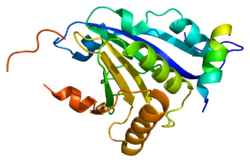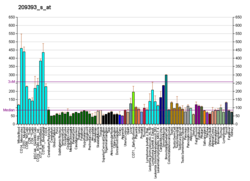EIF4E2
Protein-coding gene in the species Homo sapiens
| EIF4E2 | |||||||||||||||||||||||||||||||||||||||||||||||||||
|---|---|---|---|---|---|---|---|---|---|---|---|---|---|---|---|---|---|---|---|---|---|---|---|---|---|---|---|---|---|---|---|---|---|---|---|---|---|---|---|---|---|---|---|---|---|---|---|---|---|---|---|
 | |||||||||||||||||||||||||||||||||||||||||||||||||||
| |||||||||||||||||||||||||||||||||||||||||||||||||||
| Identifiers | |||||||||||||||||||||||||||||||||||||||||||||||||||
| Aliases | EIF4E2, 4E-LP, 4EHP, EIF4EL3, IF4e, eukaryotic translation initiation factor 4E family member 2, h4EHP | ||||||||||||||||||||||||||||||||||||||||||||||||||
| External IDs | OMIM: 605895; MGI: 1914440; HomoloGene: 128466; GeneCards: EIF4E2; OMA:EIF4E2 - orthologs | ||||||||||||||||||||||||||||||||||||||||||||||||||
| |||||||||||||||||||||||||||||||||||||||||||||||||||
| |||||||||||||||||||||||||||||||||||||||||||||||||||
| |||||||||||||||||||||||||||||||||||||||||||||||||||
| |||||||||||||||||||||||||||||||||||||||||||||||||||
| |||||||||||||||||||||||||||||||||||||||||||||||||||
| Wikidata | |||||||||||||||||||||||||||||||||||||||||||||||||||
| |||||||||||||||||||||||||||||||||||||||||||||||||||
Eukaryotic translation initiation factor 4E type 2 is a protein that in humans is encoded by the EIF4E2 gene.[5][6][7][8] It belongs to the eukaryotic translation initiation factor 4E family.
Interactions
EIF4E2 has been shown to interact with ARIH1.[9]
References
- ^ a b c GRCh38: Ensembl release 89: ENSG00000135930 – Ensembl, May 2017
- ^ a b c GRCm38: Ensembl release 89: ENSMUSG00000026254 – Ensembl, May 2017
- ^ "Human PubMed Reference:". National Center for Biotechnology Information, U.S. National Library of Medicine.
- ^ "Mouse PubMed Reference:". National Center for Biotechnology Information, U.S. National Library of Medicine.
- ^ Mao M, Fu G, Wu JS, Zhang QH, Zhou J, Kan LX, et al. (July 1998). "Identification of genes expressed in human CD34(+) hematopoietic stem/progenitor cells by expressed sequence tags and efficient full-length cDNA cloning". Proceedings of the National Academy of Sciences of the United States of America. 95 (14): 8175–8180. Bibcode:1998PNAS...95.8175M. doi:10.1073/pnas.95.14.8175. PMC 20949. PMID 9653160.
- ^ Rom E, Kim HC, Gingras AC, Marcotrigiano J, Favre D, Olsen H, et al. (May 1998). "Cloning and characterization of 4EHP, a novel mammalian eIF4E-related cap-binding protein". The Journal of Biological Chemistry. 273 (21): 13104–13109. doi:10.1074/jbc.273.21.13104. PMID 9582349.
- ^ "Entrez Gene: EIF4E2 eukaryotic translation initiation factor 4E family member 2".
- ^ Morita M, Ler LW, Fabian MR, Siddiqui N, Mullin M, Henderson VC, et al. (September 2012). "A novel 4EHP-GIGYF2 translational repressor complex is essential for mammalian development". Molecular and Cellular Biology. 32 (17): 3585–3593. doi:10.1128/MCB.00455-12. PMC 3422012. PMID 22751931.
- ^ Tan NG, Ardley HC, Scott GB, Rose SA, Markham AF, Robinson PA (November 2003). "Human homologue of ariadne promotes the ubiquitylation of translation initiation factor 4E homologous protein, 4EHP". FEBS Letters. 554 (3): 501–504. doi:10.1016/S0014-5793(03)01235-3. PMID 14623119. S2CID 25441190.
Further reading
- Zhang QH, Ye M, Wu XY, Ren SX, Zhao M, Zhao CJ, et al. (October 2000). "Cloning and functional analysis of cDNAs with open reading frames for 300 previously undefined genes expressed in CD34+ hematopoietic stem/progenitor cells". Genome Research. 10 (10): 1546–1560. doi:10.1101/gr.140200. PMC 310934. PMID 11042152.
- Tan NG, Ardley HC, Scott GB, Rose SA, Markham AF, Robinson PA (November 2003). "Human homologue of ariadne promotes the ubiquitylation of translation initiation factor 4E homologous protein, 4EHP". FEBS Letters. 554 (3): 501–504. doi:10.1016/S0014-5793(03)01235-3. PMID 14623119. S2CID 25441190.
- Tee AR, Tee JA, Blenis J (April 2004). "Characterizing the interaction of the mammalian eIF4E-related protein 4EHP with 4E-BP1". FEBS Letters. 564 (1–2): 58–62. doi:10.1016/S0014-5793(04)00313-8. PMID 15094042. S2CID 32997726.
- Joshi B, Cameron A, Jagus R (June 2004). "Characterization of mammalian eIF4E-family members". European Journal of Biochemistry. 271 (11): 2189–2203. doi:10.1111/j.1432-1033.2004.04149.x. PMID 15153109.
- Rual JF, Venkatesan K, Hao T, Hirozane-Kishikawa T, Dricot A, Li N, et al. (October 2005). "Towards a proteome-scale map of the human protein-protein interaction network". Nature. 437 (7062): 1173–1178. Bibcode:2005Natur.437.1173R. doi:10.1038/nature04209. PMID 16189514. S2CID 4427026.
- Okumura F, Zou W, Zhang DE (February 2007). "ISG15 modification of the eIF4E cognate 4EHP enhances cap structure-binding activity of 4EHP". Genes & Development. 21 (3): 255–260. doi:10.1101/gad.1521607. PMC 1785121. PMID 17289916.
- Ewing RM, Chu P, Elisma F, Li H, Taylor P, Climie S, et al. (2007). "Large-scale mapping of human protein-protein interactions by mass spectrometry". Molecular Systems Biology. 3 (1): 89. doi:10.1038/msb4100134. PMC 1847948. PMID 17353931.
- Rosettani P, Knapp S, Vismara MG, Rusconi L, Cameron AD (May 2007). "Structures of the human eIF4E homologous protein, h4EHP, in its m7GTP-bound and unliganded forms". Journal of Molecular Biology. 368 (3): 691–705. doi:10.1016/j.jmb.2007.02.019. PMID 17368478.
- Zuberek J, Kubacka D, Jablonowska A, Jemielity J, Stepinski J, Sonenberg N, Darzynkiewicz E (May 2007). "Weak binding affinity of human 4EHP for mRNA cap analogs". RNA. 13 (5): 691–697. doi:10.1261/rna.453107. PMC 1852817. PMID 17369309.
External links
- Overview of all the structural information available in the PDB for UniProt: O60573 (Eukaryotic translation initiation factor 4E type 2) at the PDBe-KB.
- v
- t
- e
PDB gallery
-
 2jgb: STRUCTURE OF HUMAN EIF4E HOMOLOGOUS PROTEIN 4EHP WITH M7GTP
2jgb: STRUCTURE OF HUMAN EIF4E HOMOLOGOUS PROTEIN 4EHP WITH M7GTP -
 2jgc: STRUCTURE OF THE HUMAN EIF4E HOMOLOGOUS PROTEIN, 4EHP WITHOUT LIGAND BOUND
2jgc: STRUCTURE OF THE HUMAN EIF4E HOMOLOGOUS PROTEIN, 4EHP WITHOUT LIGAND BOUND
 | This article on a gene on human chromosome 2 is a stub. You can help Wikipedia by expanding it. |
- v
- t
- e





















